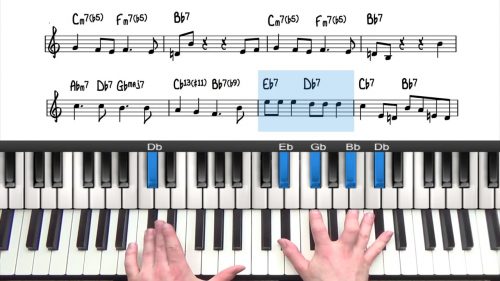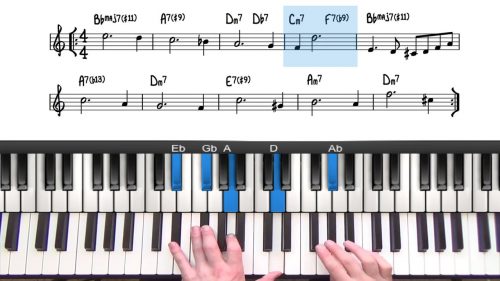Add Inner Voices To Your Voicings
In this 5 Minute Masterclass we’ll explore how to add inner voice movement to your chords when playing jazz piano. You can hear this in the playing of many of the jazz greats, Bill Evans, Barry Harris, & Kenny Barron to name just a few.
We going to explore inner voice movement over major, minor, and dominant chords. And then we will apply this information to a well-known jazz standard.
Inner Voices Over Minor Chords
Let’s start with minor chords, how can we add additional interest with inner voices over any minor we come across?
Well, there are 4 notes that you can always use for inner voice movement over minor chords. Using C Minor as an example, we can add inner voice movement using the 6, minor 7th, major 7th, and the root. Having this moving voice in the LH adds harmonic and rhythmic variety that you can use over any minor chord you come across. A handy thing to remember.
Next Let’s Explore Dominant Chords:
For dominant chords, you have a lot more freedom to use any notes from the chromatic scale. Here’s a C7 with the chromatic scale in the RH.
You can incorporate the altered tensions into inner voices:
• G-11 – C7#9 drop 13-#5-5 and then b9 to 5 of F
• G-9 – C13#11 drop #11-11-3 and then b9 to the 13 of F
You should be aware of how you resolve the tension, you can do this by targeting the chord tones of the 1 chord. A related concept here is inner voices using Sus Chords. Check out the course on chord substitutions for more information on this type of voicing.
Inner Voicings Over Major Chords.
For major chords, you can get some lovely inner voice movement between the 5, #5, 6 & 7. We will look at a few patterns for C Major. It’s nice to play these with both hands and it’s a useful tool when sat on a major chord for a whole bar or longer.
Practice Tips
-
Start by taking these inner voices around all 12 keys so that you can visualise them on the keyboard.
-
The next step is to play them within a 251 progression, or a 2516 (1625) progression. Keep cycling around and experimenting with these voices on the different chord types.
-
Once you understand how to use these voicings, it's time to apply these inner voices to the jazz standards you are working on.
-
Look out for space in the melody or harmony. These inner voices work great to add interest when the harmony and/or melody is static.
-
Once you understand these concepts and have applied them to the jazz standards you are working on, you should then be able to hear this kind of movement on recordings.
-
The final (and most important!) step is to study the recordings of the jazz greats. In particular, check out the recordings of Bill Evans, Barry Harris, & Kenny Barron who are masters at using these devices in their playing.
- A related concept here is inner voices using Sus Chords. Check out the related lesson section above.






Awesome! Thanks Hayden!
My pleasure James… this was a fun lesson to make and lots more of these to come from myself and the other PianoGroove teachers. Cheers!
My pleasure James… this was a fun lesson to make and lots more of these to come from myself and the other PianoGroove teachers. Cheers!
Please keep these 5 minute lessons coming. Great stuff to experiment with! Thanks Hayden!
Great stuff, thanks Adam… there’s many more of these lessons in the pipeline. Stay tuned :-)
This is great. Thanks Hayden :) I like the updated theme music too.
Hi Natasha 👋
Glad to hear it. These short lessons are fun to make too :-)
I have just published another 5 Minute Masterclass on ‘Dominant Passing Chords’. Check it out here: pianogroove.com/jazz-piano-lessons/slick-dominant-passing-chords/ – this one ran away with me a little and it ended up 7.5 minutes!
The updated theme music is a 251 in Bb Major with a distinctive diminished pattern played over F7. One of Tuomo’s upcoming Masterclasses is exactly this topic… “Diminished Scale Patterns” and he will break down this sound over dominant chords.
As we ramp up with more teachers, lots of these lessons will be landing on a regular basis.
Cheers!
Hayden
Add the inner voice movement note #5 to a major blues scale and the maj7 note to a minor blues scale will create more colorful sounding :)
Hi Yuezhou 👋
Yes that’s a nice colour to add…. Brilliant suggestion!
The #5 in the major blues scale gives you the chromatic passing tone between the 5 and 6 which can be nice too add additional colour and tension.
The maj7 note in the minor blues scale gives you the ‘melodic minor’ or ‘jazz minor’ sound. One of my favourites colours! :-)
Listen to how Chet Baker uses the maj7 over the C-7 chord here: pianogroove.com/jazz-piano-lessons/chet-baker-minor-251-line/ – a very nice sound to play around with, and combine with the minor blues scale.
Cheers!
Hayden
Really need to print the 8 bars to take to my piano. Where is that possible?
Phenomenal Hayden. Very well done. Give Thanks 🔥🙌🏾😎💫
Thanks for the tips. How do you recommend the sustain pedal is to be used when applying inner voice movment
Where can I type in 12 bar Blues with gospel? cords.?
Leo Edwards
Hi Leo,
Our blues and gospel lessons are all in the blues section which is here: pianogroove.com/blues-piano-lessons/ – you can find this section under “Lessons” >> “Blues Piano Lessons”.
There are 2 courses on the 12 bar blues with gospel style chord changes, and you can find them here:
pianogroove.com/blues-piano-lessons/slow-blues-piano-for-beginners/
pianogroove.com/blues-piano-lessons/slow-blues-in-c-harmony-improv/
Please let me know if you have any other questions.
Talk soon,
Hayden